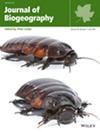Phylogeography of the Red-Headed Manakin Supports the River-Refuge Hypothesis
Abstract
Aim
The Amazon rainforest is one of the most biodiverse regions on earth, but our understanding of the processes that have shaped its patterns of diversity remains incomplete. One hypothesis for Amazonian speciation is the river-refuge hypothesis, which suggests that retraction of forests away from the periphery of Amazonia, where rivers are narrow, facilitated divergence of populations separated by wide rivers. Later re-expansion of forests would have allowed secondary contact between these populations, and co-occurring hybrid zones may reveal the location where expanding forests first reconnected. Here, we test whether a widespread Amazonian songbird species shows evidence of population contact zones in the eastern headwaters of the Tapajós river, hypothesised to be an area of secondary contact under the river-refuge hypothesis.
Location
Amazon and Atlantic forests of South America.
Taxon
Ceratopipra rubrocapilla (Pipridae, Passeriformes).
Methods
We sampled 147 C. rubrocapilla (Red-headed Manakin) across its vast range, with 70 samples sequenced using reduced-representation genomic sequencing and 139 sequenced at the mitochondrial gene cytochrome b. We use population genetic and phylogenetic analyses to investigate patterns of gene flow and population structure across the range, with a particular focus on samples from the headwaters of the Tapajós River to evaluate the potential role of the river-refuge hypothesis.
Results
We observe shallow population structure and evidence for widespread gene flow across the range of C. rubrocapilla. Patterns in the Tapajós headwaters match predictions of the river-refuge hypothesis, with eastern headwater samples most similar to samples farther west on the opposite bank of the Tapajós River.
Main Conclusions
The close co-occurrence between population contact zones within C. rubrocapilla and other previously studied hybrid zones reinforces the hypothesis that the eastern Tapajós headwaters is where rainforest populations reconnected in the past, following predictions of the river-refuge hypothesis of Amazonian speciation.


 求助内容:
求助内容: 应助结果提醒方式:
应助结果提醒方式:


